-
02-06-2023
The challenge of university teaching in times of the COVID-19 pandemic
Revista Brasileira de Enfermagem. 2023;76(2):e760201
Abstract
The challenge of university teaching in times of the COVID-19 pandemic
Revista Brasileira de Enfermagem. 2023;76(2):e760201
DOI 10.1590/0034-7167.2023760201
Views0This planet’s history has been a long and sometimes tortuous one. To date, a total of five disappearances of life on Earth have been distinguished: the great oxidation; the Ordovician-Silurian extinction; the Devonian extinction; the Permian-Triassic extinction; the Triassic-Jurassic extinction; and the Cretaceous-Tertiary extinction. The causes? Very varied and diverse: anoxia phenomena in the marine […]See more -
ORIGINAL ARTICLE02-06-2023
Nurses’ Work Methods Assessment Scale: a study of content validation
Revista Brasileira de Enfermagem. 2023;76(2):e20220396
Abstract
ORIGINAL ARTICLENurses’ Work Methods Assessment Scale: a study of content validation
Revista Brasileira de Enfermagem. 2023;76(2):e20220396
DOI 10.1590/0034-7167-2022-0396
Views0See moreABSTRACT
Objective:
To develop and validate the content of the Nurses’ Work Methods Assessment Scale.
Methods:
Methodological study conducted between January and February 2022, based on the Quality Standards for Nursing Care and Imogene King’s framework. A literature review was previously undertaken to design the scale. The content validation was carried out by 23 experts.
Results:
The initial version consisted of 40 items organized in four work methods identified in the literature. In the first dimension, from ten items, seven were considered, and one was reformulated. Seven of the initial ten items were considered in the second version. The third dimension consisted of seven items. In the fourth dimension, three items were reformulated, and three were excluded, leaving seven items. The final version ended with 28 items, whose Content Validity Index ranged between 0.83 and 1.
Conclusions:
The involvement of experts has become pivotal in the development and validation of the items, providing confidence to the continuity of psychometric procedures.
-
REVIEW02-06-2023
Decreased cardiac output: an integrative review
Revista Brasileira de Enfermagem. 2023;76(2):e20220265
Abstract
REVIEWDecreased cardiac output: an integrative review
Revista Brasileira de Enfermagem. 2023;76(2):e20220265
DOI 10.1590/0034-7167-2022-0265
Views0See moreABSTRACT
Objective:
to identify, in the scientific literature, the defining characteristics and contributing factors (related factors, associated conditions and populations at risk) for nursing diagnosis decreased cardiac output.
Method:
an integrative literature review, conducted between September and October 2020, with an update in March 2022, in the MEDLINE via PubMed, LILACS, SciELO, CINAHL and EMBASE databases. Using acronym PEO, studies published in the last 10 years in Portuguese, English and Spanish were included. A descriptive analysis was carried out to present the elements mapped in the literature.
Results:
analysis of 31 articles identified different elements, highlighting 4 new related factors: hyperglycemic stress, prone position, left lateral position, sleep deprivation. Individuals with a history of cardiovascular disease and males were identified as possible populations at risk.
Final considerations:
the elements for decreased cardiac output, identified in the literature, add evidence that justifies the permanence of this diagnosis in the NANDA-I classification.
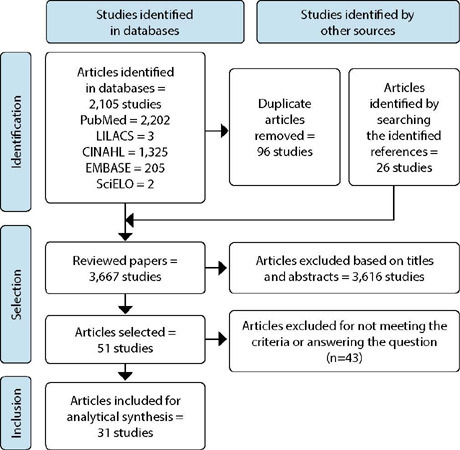
-
ORIGINAL ARTICLE02-06-2023
Spatial modeling of homicide mortality in the Northeast region of Brazil
Revista Brasileira de Enfermagem. 2023;76(2):e20220182
Abstract
ORIGINAL ARTICLESpatial modeling of homicide mortality in the Northeast region of Brazil
Revista Brasileira de Enfermagem. 2023;76(2):e20220182
DOI 10.1590/0034-7167-2022-0182
Views0See moreABSTRACT
Objective:
To analyze the spatiotemporal distribution of homicide mortality and association with social determinants of health in the Northeast Region of Brazil.
Methods:
Ecological study with spatiotemporal modeling of homicide deaths between 2000 and 2019. Temporal trends were analyzed by segmented linear regression. Crude mortality was calculated and adjusted by smoothing the local empirical Bayesian method and analyzed by the Global/Local Moran Index and spatiotemporal scan statistics. The association between social determinants of health and homicide mortality was performed using multiple linear regression and autoregressive spatial models.
Results:
353,089 deaths were recorded. Mortality increased from 2000 to 2019, with an annual increase of 4.37 in males and 3.57 in females. High risk spatial and spatiotemporal clusters were identified in the coastal region of the states. The spatial regression model showed an association with socioeconomic inequalities.
Conclusions:
High risk areas for homicides associated with socioeconomic inequality, which should be considered as a priority for designing and investing in public health policies were investigated.
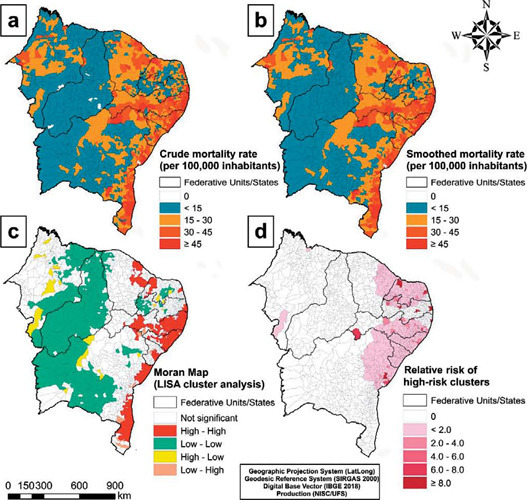
-
ORIGINAL ARTICLE02-06-2023
Teaching entrepreneurship in undergraduate Nursing course: evaluation of an educational proposal
Revista Brasileira de Enfermagem. 2023;76(2):e20210244
Abstract
ORIGINAL ARTICLETeaching entrepreneurship in undergraduate Nursing course: evaluation of an educational proposal
Revista Brasileira de Enfermagem. 2023;76(2):e20210244
DOI 10.1590/0034-7167-2021-0244
Views1See moreABSTRACT
Objective:
To evaluate a proposal for teaching entrepreneurship in an undergraduate Nursing course that uses active methodologies and activities based on the theory of meaningful learning.
Methods:
Interventional, prospective study, with a quantitative perspective, with a total of 102 participating students, carried out from July 2017 to December 2019 at a public university in the state of Sao Paulo. Statistical analysis were performed by non-parametric Chi-square or Fisher’s exact tests, with differences considered statistically significant if p < 0.05.
Results:
Improvements were observed in almost all items evaluated, revealing that meaningful learning became more effective with the use of active teaching methodologies. Most students need adaptation and effort to be put into these methods.
Conclusions:
The proposal offers pedagogical content adaptation, specifically for nursing students. New research should expand teaching-learning techniques for the development of future nurses, preparing them adequately for the job market.
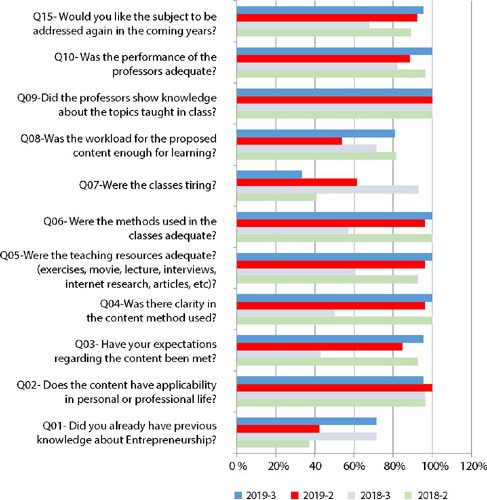
-
ORIGINAL ARTICLE02-06-2023
Psychometric properties of the Latino Students Patient Safety Questionnaire, Brazilian version
Revista Brasileira de Enfermagem. 2023;76(2):e20210961
Abstract
ORIGINAL ARTICLEPsychometric properties of the Latino Students Patient Safety Questionnaire, Brazilian version
Revista Brasileira de Enfermagem. 2023;76(2):e20210961
DOI 10.1590/0034-7167-2021-0961
Views0See moreABSTRACT
Objectives:
to assess the psychometric properties of the Latino Students Patient Safety Questionnaire, Brazilian version.
Methods:
a methodological study, carried out between April 2020 and January 2021, with 218 nursing and medicine students. Structural and discriminant construct validity were assessed by confirmatory factor analysis and cross factor loadings. Reliability was verified by McDonald’s omega, average variance extracted, composite reliability, and item-total correlation.
Results:
the final model reproduced the original structure of 21 items, distributed in five dimensions, requiring the exclusion of one item. Acceptable fit indexes were obtained (x2/gl=2.325; CFI=0.99; TLI=0.98; RMSEA=0.054). Discriminant validity was confirmed. Reliability indicators were adequate, except McDonald’s omega, in one factor (0.68), and average variance extracted, in two factors (0.41; 0.47).
Conclusions:
the instrument demonstrated evidence of internal validity and satisfactory reliability among nursing and medical students.
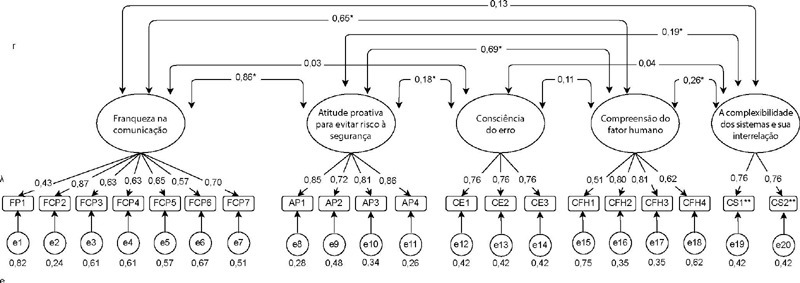
-
ORIGINAL ARTICLE02-06-2023
Perceptions about exposure to pesticides among rural school students: identified controversies
Revista Brasileira de Enfermagem. 2023;76(2):e20220101
Abstract
ORIGINAL ARTICLEPerceptions about exposure to pesticides among rural school students: identified controversies
Revista Brasileira de Enfermagem. 2023;76(2):e20220101
DOI 10.1590/0034-7167-2022-0101
Views0See moreABSTRACT
Objectives:
to identify, according to students’ perception, controversies related to the term “pesticide” and its influence on health.
Methods:
field research, with qualitative analysis via discursive textual analysis. Collective interviews were carried out with students of ninth grade of elementary school from four rural schools in the western region of Paraná.
Results:
when analyzing students’ statements, it was identified that pesticides are part of their reality and that of the local community Controversies related to pesticides and health arose, with emphasis on the form of production and the understanding of the real harm generated by exposure and use of pesticides.
Conclusions:
approaching pesticides in the context of education and health is essential so that there is a strengthening of discussions, in a critical and contextualized way, in school spaces, expanding the look at the topic as a way of enriching understandings and discourses on the subject.
-
REVIEW02-06-2023
Elements for assistance to patients with hematological malignancies to propose care lines: a scoping review
Revista Brasileira de Enfermagem. 2023;76(2):e20220152
Abstract
REVIEWElements for assistance to patients with hematological malignancies to propose care lines: a scoping review
Revista Brasileira de Enfermagem. 2023;76(2):e20220152
DOI 10.1590/0034-7167-2022-0152
Views0See moreABSTRACT
Objectives:
to identify the elements for assistance to patients with hematological malignancies to propose a care line.
Methods:
this is a scoping review, anchored in the JBI theoretical framework, with searches carried out in April 2021, in eight electronic databases and 10 repositories of theses and dissertations.
Results:
the final sample consisted of 93 studies, and the main forms of assistance provided that can support a care line for this public were imaging tests, immunophenotyping, chemotherapy regimens, radiotherapy, infection management, assessment of nutritional status, maintenance of oral function, symptom management and screening for second malignancies.
Conclusions:
the elaboration of a care line for onco-hematologic patients is necessary, considering the complexity surrounding the diagnosis and treatment of hematologic malignancies, in addition to the difficulties that are imposed in relation to access and continuity of care in the network.
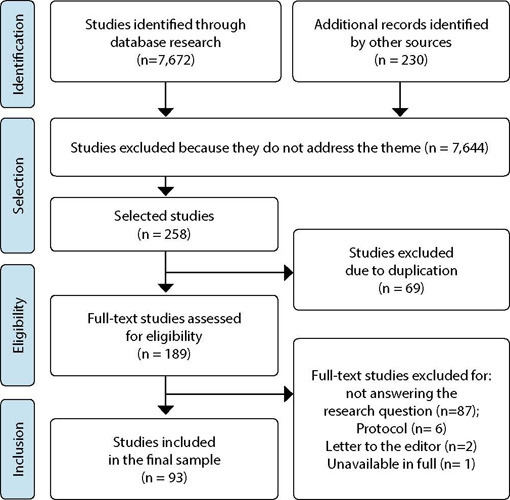
-
ORIGINAL ARTICLE09-21-2020
Nurses’ attitudes facing the family involvment in caring for people with mental disorder
Revista Brasileira de Enfermagem. 2020;73:e20200041
Abstract
ORIGINAL ARTICLENurses’ attitudes facing the family involvment in caring for people with mental disorder
Revista Brasileira de Enfermagem. 2020;73:e20200041
DOI 10.1590/0034-7167-2020-0041
Views0See moreABSTRACT
Objective:
To characterize the attitudes of Primary Health Care nurses, regarding the involvement of the family in the care for people with Mental Disorder.
Methods:
Correlational study with 257 nurses from the city of São Paulo. The scale “Importance of Families in Nursing Care- Nurses’ Attitudes” was used. For the analysis, descriptive and inferential statistics were used.
Results:
The scale scores were high, with a mean value of 82.1 (SD=8.4) favorable to the families’ involvement, and are related to being a nurse in the Family Health Strategy (p<0.001), having received education/training in family nursing (p<0.005), the workload of 40 hours/week (p<0.005), working in the West, East and Center Regions (p<0.005).
Conclusion:
Most nurses have positive attitudes towards the involvement of families, a relevant indicator for their inclusion in the health-mental care process.
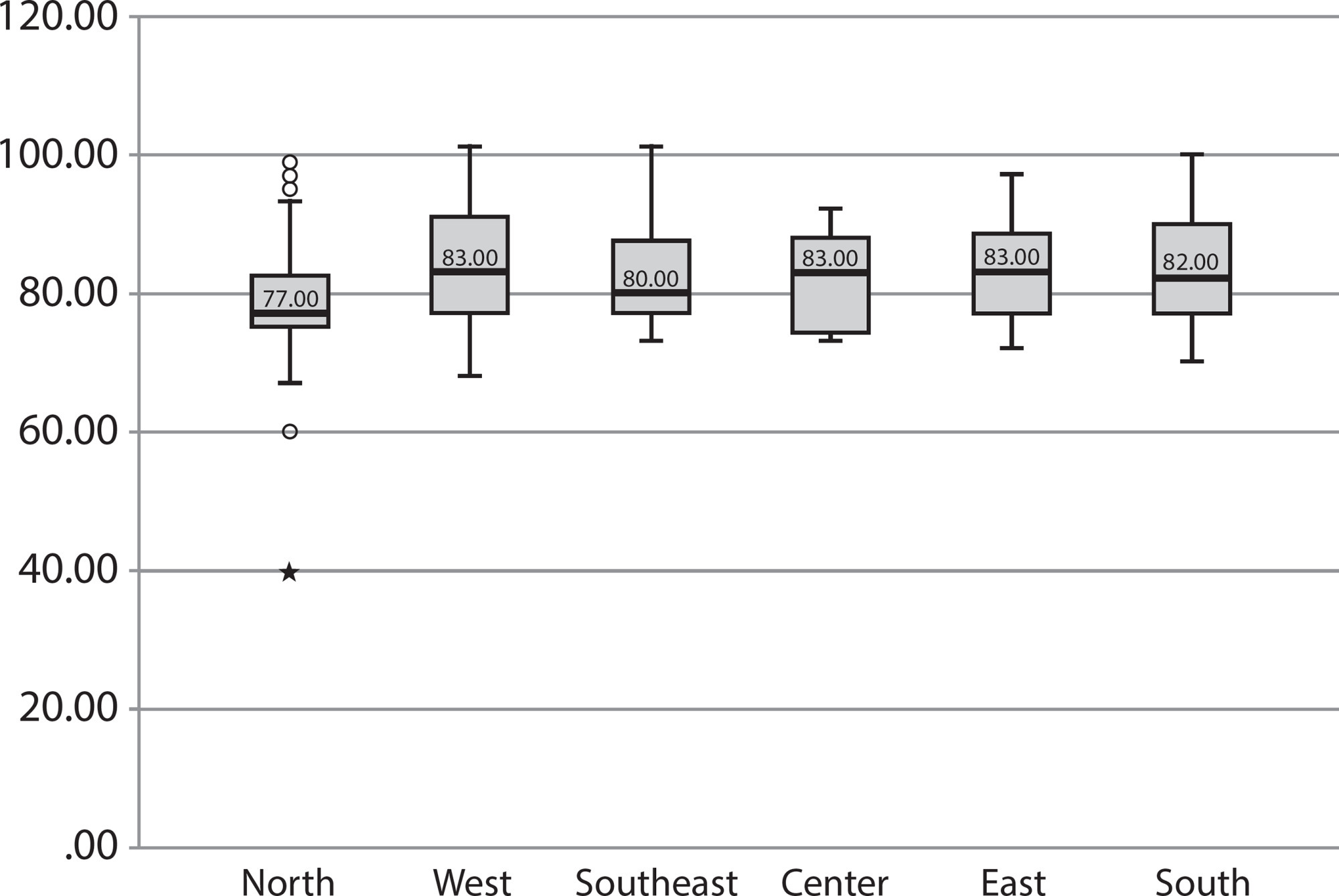
-
ORIGINAL ARTICLE02-10-2020
Night Admission at a Psychosocial Care Center III
Revista Brasileira de Enfermagem. 2020;73(1):e20170964
Abstract
ORIGINAL ARTICLENight Admission at a Psychosocial Care Center III
Revista Brasileira de Enfermagem. 2020;73(1):e20170964
DOI 10.1590/0034-7167-2017-0964
Views0See moreABSTRACT
Objective:
to analyze night admission characteristics at a Psychosocial Care Center III (CAPS III – Centro de Atenção Psicossocial).
Method:
a qualitative research, whose data were collected with 15 nursing professionals from November to April 2016, through a semi-structured interview.
Results:
it was verified that night admission is provided by the nursing team in different dynamics from the day care. This team has strategies of care during crisis, avoiding search for other network services and maintaining the CAPS in its function within the psychosocial model.
Final considerations:
service operation depends on the nursing team for its permanence condition in all shifts, which leads to the need to think about the legislation reformulation that structures the CAPS III team, in order to guarantee the interdisciplinary care provided by the Brazilian Psychiatric Reform in this device, which should replace hospitalization in a specialized institution.
-
CASE STUDY08-19-2019
Decision making from the perspective of nursing students
Revista Brasileira de Enfermagem. 2019;72(4):1102-1108
Abstract
CASE STUDYDecision making from the perspective of nursing students
Revista Brasileira de Enfermagem. 2019;72(4):1102-1108
DOI 10.1590/0034-7167-2018-0311
Views0See moreABSTRACT
Objective:
To analyze the decision making of students from a nursing higher school and understand how they make decisions in the care process.
Method:
A qualitative study with an exploratory and descriptive approach was carried out with the case study method.
Results:
Six types of decision making were categorized by the students as follows: Decision about communication (15 record units [RU]); Decision about understanding (14 RU); Decision about intervention (9 RU); Decision about timing (5 RU); Decision about targeting (4 RU); and Decision about management (0 RU), with a total of 47 RU.
Final considerations:
Analysis of the learning diaries showed that students make more decisions regarding communication with patients and understanding of the care situation, than with the acting decision.
-
ORIGINAL ARTICLE12-21-2020
Nurses’ work at Family Health Strategy: possibilities to operate health needs
Revista Brasileira de Enfermagem. 2020;73:e20190704
Abstract
ORIGINAL ARTICLENurses’ work at Family Health Strategy: possibilities to operate health needs
Revista Brasileira de Enfermagem. 2020;73:e20190704
DOI 10.1590/0034-7167-2019-0704
Views0See moreABSTRACT
Objectives:
to identify and analyze possibilities for recognizing health needs in the nurses’ work at Family Health Strategy.
Methods:
a qualitative study with interviews and observation of the nurses’ work in the countryside of São Paulo. The empirical material was subjected to thematic content analysis and interpreted in the light of the health work process.
Results:
two themes emerged: Possibilities utilized and Possibilities neglected to recognize health needs. Careful observation, welcoming, attention, listening, bonding and dialogue developed by nurses, in live work in action with users, touched on the possibilities, which, taken advantage of, were evidenced in care in spontaneous demand, scheduled consultation, examination gynecological and group activities.
Final Considerations:
nurses are able to recognize health needs, which can expand their clinical practice and interprofessionality in Family Health.
-
ORIGINAL ARTICLE08-19-2019
Social Determinants of Health and their influence on the choice of birth control methods
Revista Brasileira de Enfermagem. 2019;72(4):1044-1051
Abstract
ORIGINAL ARTICLESocial Determinants of Health and their influence on the choice of birth control methods
Revista Brasileira de Enfermagem. 2019;72(4):1044-1051
DOI 10.1590/0034-7167-2017-0574
Views0See moreABSTRACT
Objective:
To verify the association between Social Determinants of Health and birth control methods used by women of childbearing age.
Methods:
Documentary and retrospective study, performed at a Brazilian Natural Birth Center with evaluation of the medical records of patients seen between 2003 and 2011 (n=2410). Data were collected on identification and general history, gynecological, sexual and obstetric.
Results:
Hormone birth control methods were the most used among participants (25.0%); followed by barrier methods (21.5%) and surgical methods (19.3%). Statistical associations were observed regarding age, menarche, onset of sexual activity, pregnancy, miscarriage, smoking, hypertension, marital status, gynecological care and schooling with the choice of methods.
Conclusion:
The results confirm the importance of studies involving Social Determinants of Health, since they interfere in the way women choose birth control methods and the risks that this choice may pose to their health.
-
REVIEW07-13-2020
Augmentative and Alternative Communication in Ventilated Patients: A Scoping Review
Revista Brasileira de Enfermagem. 2020;73(5):e20190562
Abstract
REVIEWAugmentative and Alternative Communication in Ventilated Patients: A Scoping Review
Revista Brasileira de Enfermagem. 2020;73(5):e20190562
DOI 10.1590/0034-7167-2019-0562
Views0See moreABSTRACT
Objectives:
to map the benefits of Augmentative and Alternative Communication in ventilated adults in Intensive Care Unit and identify strategies used.
Methods:
a Scoping Review was carried out according to the Joanna Brigs Institute Protocol. The research question was: “In adult patients ventilated in Intensive Care Units, what are the benefits of Augmentative and Alternative Communication?”. An article research was carried out at PubMed, EBSCOhost and B-On databases. It was held between October and November 2018, from 2013 to 2018, in Portuguese and in English.
Results:
61 references were obtained. After selection according to the inclusion criteria, 7 articles were analyzed.
Conclusions:
studies enunciate Augmentative and Alternative Communication as a strategy to enhance communication, describing methods and tools. There is no agreement on the most effective tool.
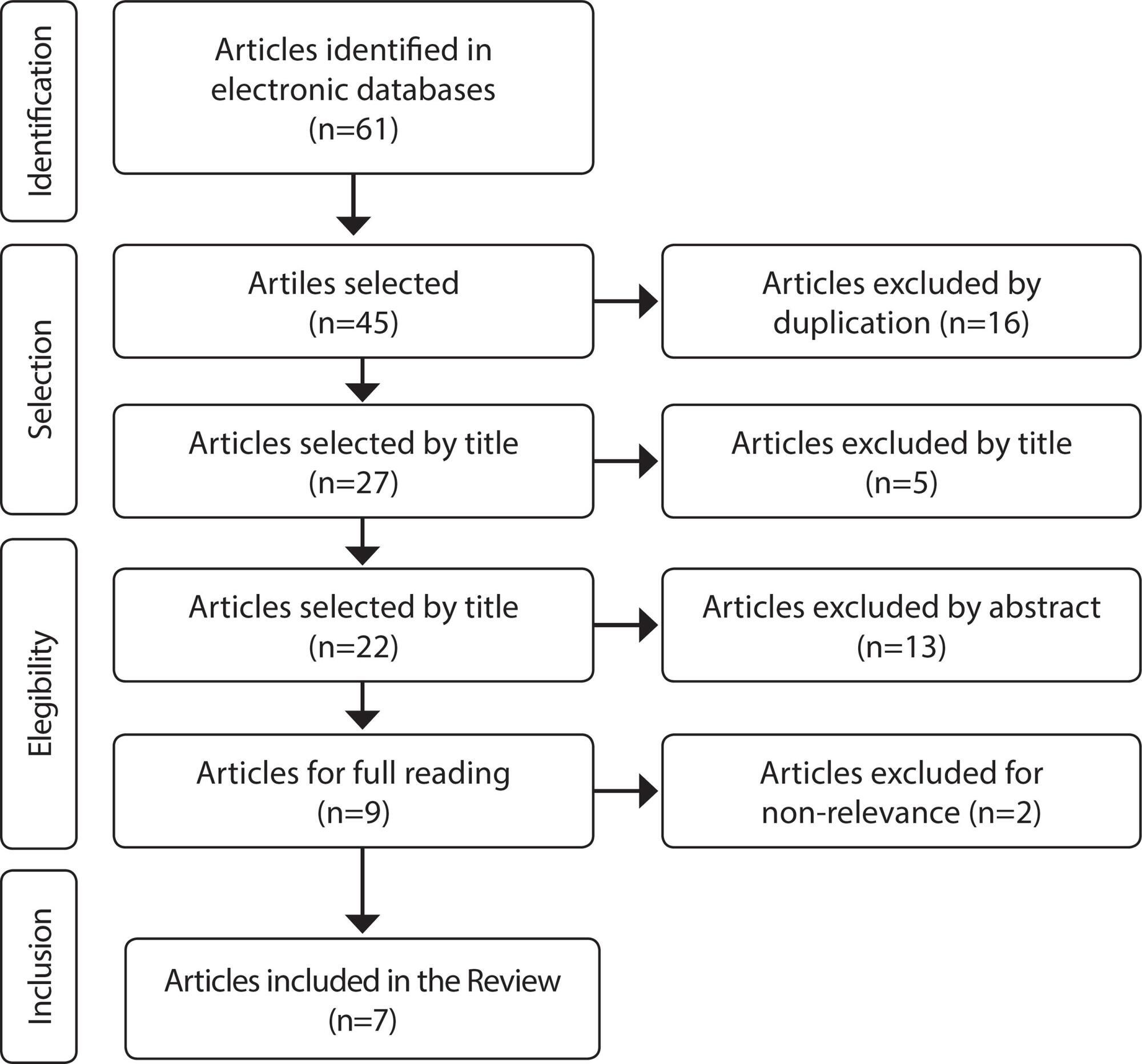
-
REFLECTION12-13-2019
Women with fetal death: nurses’ care limitations
Revista Brasileira de Enfermagem. 2019;72:365-368
Abstract
REFLECTIONWomen with fetal death: nurses’ care limitations
Revista Brasileira de Enfermagem. 2019;72:365-368
DOI 10.1590/0034-7167-2018-0261
Views0See moreABSTRACT
Objective:
To present the limitations of the nursing care for women with fetal death, reflecting on this challenge for care practices.
Method:
Reflective study with theoretical focus on national and international publications, along with the experience of the authors in the area of women’s health and obstetrics.
Results:
There are limitations related to nursing care, which involve feelings of insecurity and powerlessness, inappropriate attitudes of these professionals in front of women, difficulties to manage emotional aspects, and structural problems of health services.
Final Considerations:
This study points out that there are challenges to qualify nursing care for women with fetal death, which included academic studies and continuing education in health services. Relational aspects should be valued and demand more sensitivity from nurses, with more empathic relationships in the care for women with fetal death.
-
REVIEW10-07-2022
Strategies for thirst management in postoperative adult patients: a scoping review
Revista Brasileira de Enfermagem. 2022;75(4):e20220154
Abstract
REVIEWStrategies for thirst management in postoperative adult patients: a scoping review
Revista Brasileira de Enfermagem. 2022;75(4):e20220154
DOI 10.1590/0034-7167-2022-0154
Views0See moreABSTRACT
Objectives:
to map the strategies for managing thirst in postoperative adult patients.
Methods:
scoping review was conducted in October 2021 in 19 data sources: 14 databases and 5 platforms to search in the grey literature. It was prepared according to the recommendations of the Joanna Briggs Institute and the checklist of the Preferred Reporting Items for Systematic reviews and Meta-Analyses extension for Scoping Reviews. Nine selected articles were part of the final sample.
Results:
there is evidence of strategies to manage postoperative thirst using interventions such as water, ice, mentholated measures, carbohydrate and protein enriched fluid, oral hydrator, flavored gargling, cold gargling, wet gauze, 0.75% citric acid spray, and cold water.
Final Considerations:
the strategies observed may be reduced to cold and menthol use, salivary stimulants, and early introduction of fluids. The outcomes were positive in all the studies reviewed.
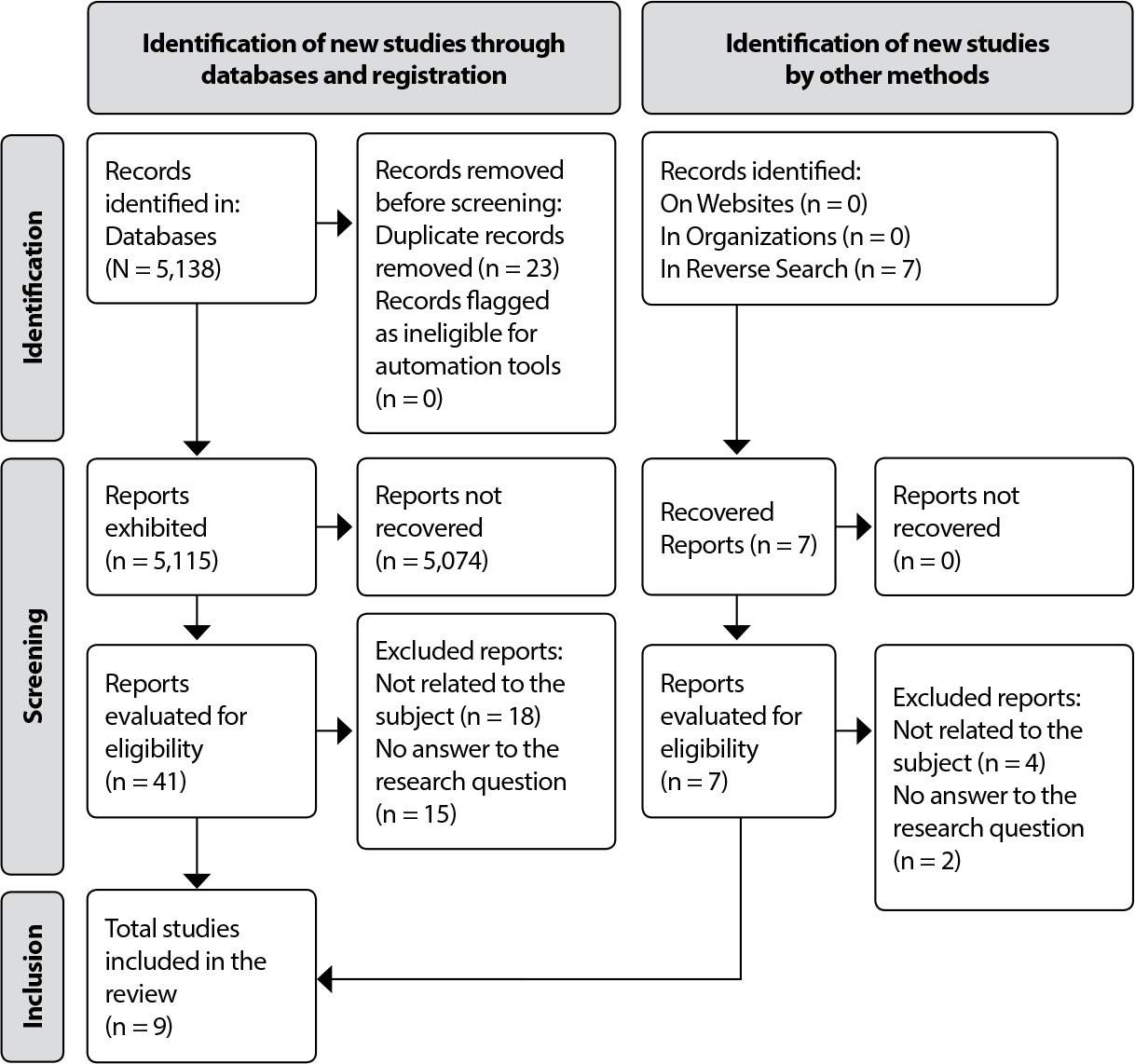
Search
Search in:
Nuvem de Tags
Adolescente (85) Atenção Primária à Saúde (239) COVID-19 (91) Criança (91) Cuidados de Enfermagem (269) Educação em Enfermagem (151) Educação em Saúde (139) Enfermagem (930) Enfermagem Pediátrica (86) Estudantes de Enfermagem (77) Estudos de Validação (131) Família (87) Idoso (208) Promoção da Saúde (99) Qualidade de Vida (104) Saúde do Trabalhador (86) Saúde Mental (145) Saúde Pública (82) Segurança do Paciente (150) Tecnologia Educacional (100)



